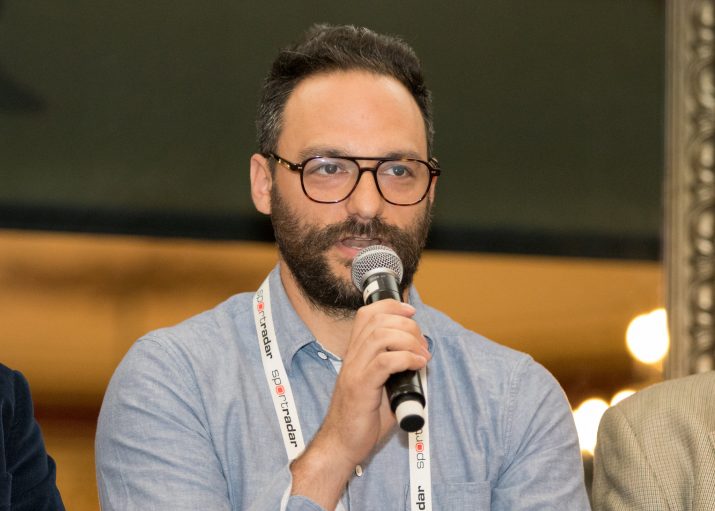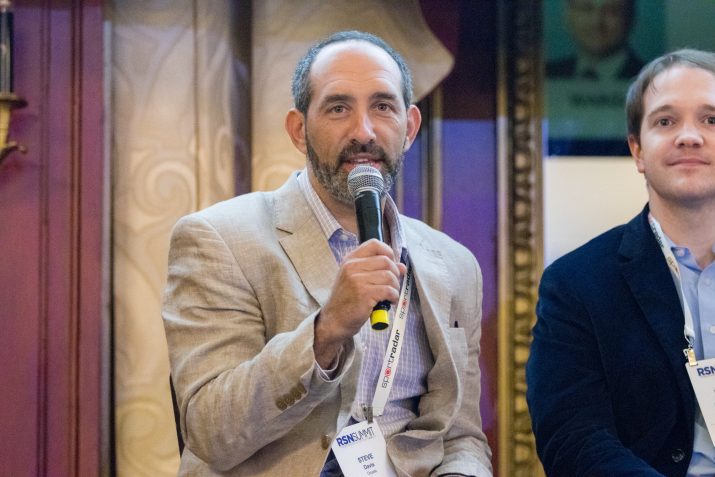RSN Summit: RSN Experts Discuss Marriage of Digital, Linear Production Teams
Story Highlights
Executives from the Regional Sports Network (RSN) community discussed the growing unified relationship between digital and linear production teams, how it is impacting hiring and workflows, and how linear and digital production philosophies are influencing content creation for the other.
Larry Meyers, EVP, Content, Pac-12 Networks said that one of the goals is to have a barrier-less relationship between parts of the company that have long operated in separate circles. Studio operations and digital and editing teams are all aware that the goal is to create content that can be served out in a multiplatform world.
“The strategy for creating content may vary a little from platform to platform, but the mission is still to connect fans across a national network and six regional networks to the schools they love,” he explains. “It’s a different approach, but with the same result.”
That different approach is also impacting technology providers. Steve Davis, Chief Revenue Officer, Ooyala said that companies like Ooyala are looking to help automate many of the processes that are required to get content out to both digital and linear viewers.
“More and more, it is about shared metadata and workflows, even if the content is different,” explained Davis. “They need a common MAM or workflow for cost savings and also to speed up access to content. And they want to make [content creation] for both cheaper, with automation in the middle that can work with different departments.”

MSG Networks’ Kevin Marotta
Kevin Marotta, SVP, Marketing and Content Strategy, MSG Networks, said that those involved in content creation for linear or digital are increasingly embracing a cultural change where they have more creative freedom with respect to storytelling. One way the digital world has changed linear content creation is that programs and segments are increasingly freed from having to be cut or extended to fit into a 30-minute or one-hour program.
“We can tell the stories in as efficient away as possible, and if we can only get 10 minutes with a player, that is OK because we only need a few minutes of content,” added Marotta.
The production team isn’t the only one adjusting to a more unified world. Sales teams are also becoming more integrated and the days of having separate sales, buyers, and agencies for different platforms are giving way to integrated sales efforts as brands look to connect across all platforms.
One thing all of the panelists agreed on is that the days of “good enough” for digital are long gone. Michael R. Hall, SVP, Digital, NESN, said the production values need to be as high as they can for both platforms, a move that ensures that content that comes out of the digital team can be worthy of being shown on air.
Hall hinted at another challenge facing the industry: serving two masters, and not just the platforms. At its core, a regional network is serving fans in a fairly limited geographical zone and typically over cable operators within that zone. But digital delivery has created the opportunity to reach fans across the country and that can require different production teams to make content for each.

Ooyala’s Steve Davis, alongside NESN’s Michael R. Hall
The evolution within the production teams is also impacting the skill set that the networks are looking for in employees. As the quality of digitally delivered content continues to rise, there is also a rise in the interest in hiring people who have broadcast-technology experience. And when networks are hiring on-air talent, those new hires are expected to join a network with a built-in audience via a social media following, ideally a following that is younger.
Regardless of what role a person has on a digital team, they are often excited to have a chance to be involved in creating content for delivery on air. On-air talent on the digital side, for example, are starting to focus less on quips and humor and more on playing it straight. And in a world of increased consolidation, Hall said they are also sticking around longer than they might have anticipated as they take advantage of the ability to develop their career and sharpen their skills.
Michael Wargo, Senior Director of Multi-Platform Content, NBC Sports Regional Networks, said the philosophy at NBC Sports is don’t look at the voice and tone of each platform, as the lines are blurring. At NBC Sports, for example, content teams are divided up by the teams they cover, not the platform. In addition, the fans in Boston may not be looking for the same thing as fans in the Bay Area, although Hall said often those differences don’t vary too much.
And while fans in different markets may have slightly different needs, there are some consistent challenges for those creating content for digital delivery. Content that is delivered digitally, for example, often is under the pressure to hook the viewer within the first three seconds and, often, without sound.
“Our creative services team in Stamford distributed to RSNs a similar look and feel on how to package content, and they spent a lot of time looking at every content distribution scenario,” said Wargo. “We have templates for content that needs to get out quickly when time matters, but everyone has a tool kit and an understanding how to use it. You need to make sure the teams are in a position to succeed, and that means training on new equipment.”
Increasingly, that new equipment is becoming more intuitive, automated, and capable. And for many production professionals, that means less need to focus on mundane tasks and more time to focus on what matters: tightening the relationship with passionate sports fans with content that speaks directly to them in new ways, on new devices, and on new platforms.
